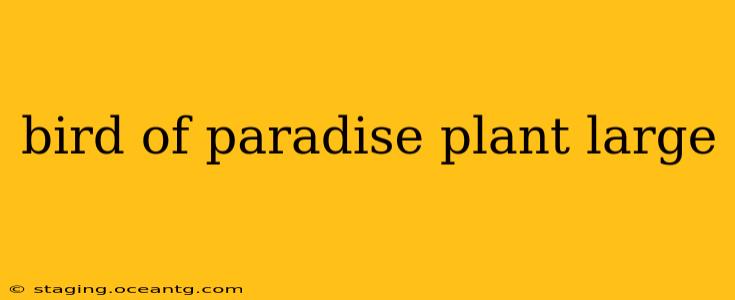The Bird of Paradise plant, with its striking, exotic blooms, is a coveted addition to any home or garden. But achieving a truly large, thriving specimen requires understanding its specific needs. This comprehensive guide will delve into the essential aspects of cultivating a magnificent Bird of Paradise, answering common questions and providing expert tips for success.
What are the different types of Bird of Paradise plants?
There are several species within the Strelitzia genus, but the most commonly cultivated as houseplants and garden ornamentals are Strelitzia reginae (commonly called Bird of Paradise flower) and Strelitzia nicolai (Giant White Bird of Paradise). Strelitzia reginae is smaller, typically reaching heights of 4-6 feet, while Strelitzia nicolai can become significantly larger, reaching heights of 20-30 feet or more. Understanding the variety you've chosen is crucial for determining its ultimate size and care requirements. Other less common varieties exist, each with its unique characteristics and size potential.
How big do Bird of Paradise plants get?
As mentioned above, the size of your Bird of Paradise plant depends largely on the species. Strelitzia reginae stays relatively compact, ideal for containers or smaller gardens. Strelitzia nicolai, on the other hand, is a substantial plant, best suited for larger outdoor spaces where it has ample room to grow. Even within a species, factors like growing conditions—sunlight, watering, and soil quality—significantly influence the plant's final size. Proper care will encourage robust growth and a larger, more impressive plant.
How long does it take a Bird of Paradise plant to grow large?
The time it takes for a Bird of Paradise plant to reach its full size varies considerably based on the species, environmental factors, and the plant's overall health. Generally, Strelitzia reginae will mature more quickly than Strelitzia nicolai. Expect several years, even a decade or more, for a Strelitzia nicolai to reach its full potential. Consistent care, providing the optimal conditions discussed below, will accelerate the growth process.
How much sun does a large Bird of Paradise plant need?
Sunlight is crucial for the healthy development and blooming of your Bird of Paradise. Both Strelitzia reginae and Strelitzia nicolai thrive in bright, indirect sunlight. While they can tolerate some direct sun, especially morning sun, prolonged exposure to intense afternoon sun can scorch their leaves. In hotter climates, providing some afternoon shade is recommended. If growing indoors, place the plant near a south-facing window, but ensure it's shielded from the harshest rays.
What kind of soil does a Bird of Paradise plant need?
Well-draining soil is paramount for the health of a Bird of Paradise plant. These plants are susceptible to root rot if their roots sit in soggy soil. A soil mix that retains some moisture but allows for excellent drainage is ideal. A blend of potting soil, perlite, and coarse sand provides a suitable growing medium. Consider adding compost for added nutrients. Ensure the container has adequate drainage holes to prevent waterlogging.
How often should I water a large Bird of Paradise plant?
Watering requirements vary depending on the size of the plant, the climate, and the type of soil. Generally, allow the top inch or two of soil to dry out between waterings. Avoid overwatering, which can lead to root rot. During the growing season (spring and summer), you may need to water more frequently. Reduce watering frequency during the dormant period (fall and winter). Always check the soil moisture before watering to prevent both underwatering and overwatering.
Can I grow a Bird of Paradise plant in a pot?
Yes, Bird of Paradise plants, particularly Strelitzia reginae, can be successfully grown in large containers. Choose a pot with ample drainage holes and a size appropriate for the plant's root system. Repotting every few years, as the plant grows, will provide more space for root development and contribute to a larger, healthier plant. Remember that container-grown plants will generally reach a smaller size than those planted directly in the ground.
By following these guidelines and tailoring your approach to your specific plant and environment, you can successfully cultivate a magnificent, large Bird of Paradise plant, a true showstopper in your home or garden. Remember patience is key; these plants are rewarding but take time to reach their full potential.
